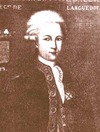TEHORENHAEGNON, Huron medicine-man, considered one of the “two greatest sorcerers in the country”; fl. 1628–37.
Indian medicine-men had a profound knowledge of medicinal herbs, considerable skill in healing wounds and tumours, and also exercised tremendous influence by treating illness and diverting disaster by calling on supernatural forces, by practising frauds, and by enforcing ceremonial dances, songs, and games, for which they received handsome rewards.
In 1628 and again in 1635, Tehorenhaegnon, having failed to fulfil his promises of rain, proclaimed that the cross which stood before the Jesuit house at Toanché II and at Ihonatiria (in the Penetanguishene peninsula) was the cause of droughts, famine, and fires by which three villages had recently been destroyed. He held a feast to avert bad luck from an eclipse of the moon that occurred on 27 Aug. 1635.
In the epidemics of 1637, he boasted of a secret remedy learned from the demons after a 12- or 13-day fast in a cabin on the shore of the lake. The village of Ossossanë (La Conception), accordingly, requested his services. Tehorenhaegnon sent one of his associates, Saossarinon, to whom he communicated his power, giving him his bow and arrows to represent him. Three days of feasting were ordered as protection against disease for all who attended. Saossarinon made the rounds of the cabins and visited the sick, while the men of the village assembled in the largest cabin and spent the night singing, dancing, and beating on pieces of bark. At daybreak Saossarinon entered amid a profound silence. He was preceded by a captain bearing Tehorenhaegnon’s bow and a kettle of water with which to sprinkle the sick. Saossarinon gravely fanned those present with a turkey wing and passed around a liquid to drink. Having thus inspired the company with courage, he withdrew. A feast followed. Then the men left the place to the women who sang and danced in turn, but did not partake of the feast. The second day’s feast was given by Saossarinon, but the third was not held “for lack of fish.” Before departing, Saossarinon taught his secrets to two residents of Ossossanë, giving them turkey wings as tokens of his power. The ceremonies proved only partially successful, however, and a messenger went again to Tehorenhaegnon. Saossarinon returned but this time refused to visit the sick, insisting that they be brought to him. The people of Ossossanë lost faith and the turkey wings were discarded.
As the epidemics continued to ravage the country, Tehorenhaegnon’s reputation is said to have dwindled, when his sweat-baths, feasts, potions, and ordinances proved of no avail.
© 1966–2024 University of Toronto/Université Laval
Cite This Article
Elsie McLeod Jury, “TEHORENHAEGNON,” in Dictionary of Canadian Biography, vol. 1, University of Toronto/Université Laval, 2003–, accessed April 26, 2024, http://www.biographi.ca/en/bio/tehorenhaegnon_1E.html.
The citation above shows the format for footnotes and endnotes according to the Chicago manual of style (16th edition). Information to be used in other citation formats:
| Permalink: | http://www.biographi.ca/en/bio/tehorenhaegnon_1E.html |
| Author of Article: | Elsie McLeod Jury |
| Title of Article: | TEHORENHAEGNON |
| Publication Name: | Dictionary of Canadian Biography, vol. 1 |
| Publisher: | University of Toronto/Université Laval |
| Year of publication: | 1966 |
| Year of revision: | 1979 |
| Access Date: | April 26, 2024 |





